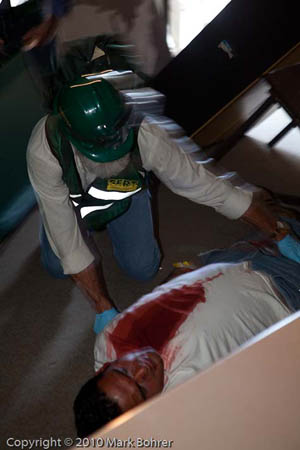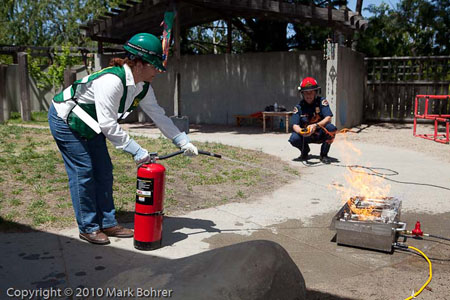You’re sitting at your lab bench with a hot soldering iron in your hand. It’s almost quitting time, but you’re making some last minute changes to a test board you want to try out before you go.
Suddenly, everything starts to shake. You get up to walk to a doorway, and it feels like you’re surfing a rogue wave. You stumble across the moving floor, past shelves piled with oscilloscopes and other test equipment. Reaching the lab’s doorway, you see co-workers holding scared East Coast visitors in another doorway across the hall.

Finally, after what seems like an eternity, the shaking stops.
Will you be ready to help pick up the pieces?
That was the scenario at the disaster preparedness exercise held by West Valley College and the city of Saratoga last Saturday, April 24, 2010. Community Emergency Response Team (CERT) volunteers, Amateur Radio Emergency Service operators, Santa Clara County firemen, Santa Clara County Sheriff’s Department officers, and officials from West Valley College and California state and local governments participated in this practice for a real disaster.
CERT volunteers conducted neighborhood damage assessment and reported to amateur radio operators at Saratoga’s emergency operations center. Then CERTs triaged patients, and transported those needing immediate care to the Red Cross shelter at Saratoga High School for treatment. Volunteers would be on their own in an actual event, with medical and ambulance services overwhelmed and unavailable.
At West Valley College, CERT volunteers did indoor search and rescue of patients in a close simulation of an earthquake-damaged classroom. They also received instruction from Santa Clara County fire department paramedic Rob Hecocks in fire extinguisher use, and got to practice putting out small fires.

In another drill, CERT volunteers practiced cribbing, a way to raise debris and free trapped victims. Using a lever to lift and place supporting 4x4s and 2x4s, a weighted wooden platform was lifted just high enough to allow a dummy victim to be pulled to safety.
A CHP helicopter crew answered questions and demonstrated patient loading for transport after landing their aircraft on campus. Helicopters may be the only way to transport supplies and patients requiring advanced medical care in an emergency, as the recent earthquake in Haiti demonstrated.

Many professionals and volunteers participated in the exercise. It was planned by West Valley College professor and former Federal park ranger Kim Aufhauser and Santa Clara County Emergency coordinator Jim Yoke, with input from Amateur Radio Emergency Service coordinator Don Steinbach, the Santa Clara Valley Red Cross, and West Valley College President Lori Gaskin<. Paramedic Rob Hecocks and other members of the Santa Clara County Fire Department provided training and support. California's DRCCC director of emergency preparedness Peter Wright and Saratoga City Council member Chuck Page represented state and local government.
With practice from exercises like this one, government and volunteer organizations will be better prepared for surprises during an actual disaster.
In earthquake country, it's just a matter of time until the next big one hits.
Story Notes –
The story at the start of this post came from my experience during California’s Loma Prieta earthquake of 1989, when I was a design engineering supervisor at a Silicon Valley semiconductor company. Preparedness exercises will help prevent headless-chicken responses in an actual emergency.
Shot Notes –
When I’m shooting spot news in anything from darkened rooms to bright sun, I use flash. I’ll need the extra light indoors in the dark, but flash fill will brighten dark shadows on faces when there’s some ambient light. I set flash and camera for autofocus assist to get sharpness in the dark.
I always carry spare cameras. On this shoot, I accidentally dropped one camera on pavement – even though it was in a case, the metal body cracked. My backup Leica M8 gave me second-camera flexibility as I covered the exercise.
I’m not talented enough to be in two places at once, so I had my wife Pat photograph in the Emergency Operations Center (EOC) while I was shooting CERT neighborhood damage assessment. She also captured wider, establishing shots of scenes, letting me concentrate on close views of specific action. Between the two of us, we told a more complete story of the exercise.

Recent Comments